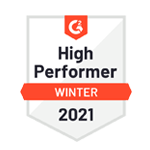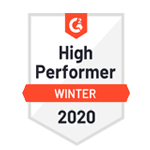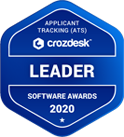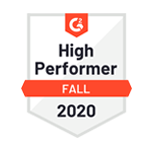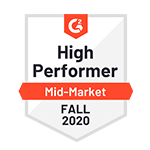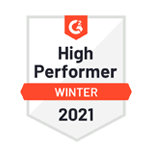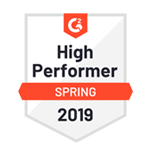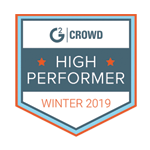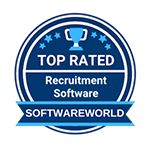Talent acquisition success hinges on one critical metric: quality of hire. While filling positions quickly matters, bringing the right people into your organization determines long-term success.
Organizations focusing on quality recruitment metrics optimize hiring strategies, reduce costs, and enhance employee satisfaction and productivity. Your hiring decisions today shape your competitive advantage tomorrow.
This guide explores proven practices that transform how staffing agencies and recruitment teams approach talent acquisition. You’ll discover actionable strategies to attract, assess, and onboard high-quality candidates.
What is Quality of Hire and Why It Matters?
Quality of hire measures the value new employees bring to your organization over time. This metric combines multiple performance indicators into a comprehensive assessment of talent acquisition effectiveness.
Defining Quality of Hire as a Recruitment Metric
Quality of hire reflects the value a new employee brings to an organization, encompassing both pre-hire and post-hire experiences. It evaluates how well new hires integrate, perform, and contribute to organizational goals.
Pre-hire quality indicators include assessment scores, work samples, and structured interview results. Post-hire quality measures encompass time to proficiency, productivity metrics, and performance ratings.
Unlike simple metrics like time-to-hire, quality of hire provides deeper insights. You understand not just how fast you hire, but how well those hires perform.
The Business Impact of Quality Recruitment
High-quality hires drive productivity, minimize turnover, and potentially increase revenue, directly improving recruitment return on investment. The financial implications extend far beyond initial hiring costs.
Poor quality hires create cascading problems. They waste resources, diminish team performance, and increase turnover expenses. Organizations with low quality of hire struggle with engagement and productivity.
Strong quality of hire metrics correlate with improved workplace culture. Employees who fit well stay longer, work harder, and contribute innovative ideas.
Understanding Pre-Hire vs Post-Hire Quality Assessment
Distinguishing between pre-hire and post-hire quality helps you optimize different recruitment stages. Each phase requires specific evaluation approaches and metrics.
Pre-Hire Quality Indicators and Metrics
Pre-hire quality focuses on identifying candidates with the right skills, cultural alignment, and success potential. Pre-hire quality checkers include assessment scores, work samples, and structured interviews.
Key pre-hire indicators include candidate experience levels, assessment performance, and interview consistency. You also evaluate sourcing channel effectiveness and application completion rates.
Time-to-hire and candidate engagement during the recruitment process signal pre-hire quality. Strong candidates move efficiently through your pipeline with consistent communication.
Post-Hire Performance Evaluation Methods
Post-hire quality measures how quickly and effectively new employees adapt to roles. Post-hire quality measures include time to proficiency, time to productivity, and performance metrics like goal achievement.
Employee retention rates, engagement scores, and manager satisfaction surveys provide post-hire insights. Performance review ratings and cultural fit assessments complete the picture.
The first 90 days prove critical for evaluation. Early performance indicators often predict long-term success and retention likelihood.
How to Measure and Calculate Quality of Hire?
There’s no unique formula to measure quality of hire, which makes it difficult for teams to track. However, systematic approaches yield actionable insights.
Key Quality of Hire Metrics to Track
Essential metrics include job performance ratings, employee retention, employee engagement, and ramp-up time. Each metric reveals different aspects of hiring effectiveness.
Track new hire retention rates, measuring how many employees stay beyond 90 days, six months, and one year. Monitor performance review scores and goal achievement percentages.
Employee engagement surveys provide valuable data points. Measure manager satisfaction with new hires and peer feedback through 360-degree reviews.
The Quality of Hire Formula Explained
A practical formula combines multiple factors into a single score:
Quality of Hire = (Performance + Value Addition + Relevancy + Retention) / Total Factors
Performance measures job execution and goal achievement. Value addition assesses unique contributions and innovation. Relevance evaluates skill-role alignment.
Retention tracks how long quality employees stay. Weight each factor based on organizational priorities and role requirements.
Creating Your Ideal Candidate Persona
Benchmark every candidate against an ideal profile. Start by analyzing your best performers and identifying common characteristics.
Map skills, experience levels, cultural attributes, and behavioral traits. Document both technical competencies and soft skills that drive success.
Use this persona for gap analysis during candidate assessment. Calculate scores for each feature and compare candidates objectively.
5 Strategic Practices to Improve Quality of Hire
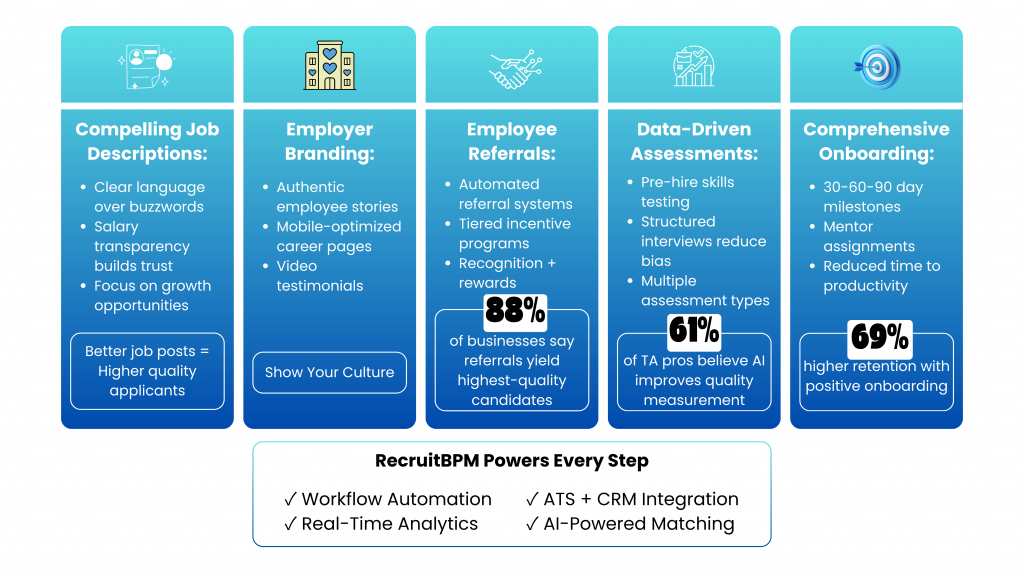
These proven practices help you attract, assess, and retain high-quality talent. Implementation requires commitment but delivers measurable results.
1. Craft Compelling and Precise Job Descriptions
Most job postings are written to weed out weaker candidates, not attract stronger ones. Shift your approach from filtering to attracting.
Elements of High-Converting Job Posts
Strong job descriptions balance specificity with appeal. Clearly outline responsibilities, required skills, and growth opportunities without overwhelming candidates.
Focus on what makes the role compelling. Highlight unique projects, learning opportunities, and team dynamics that differentiate your position.
Include salary ranges when possible. Transparency builds trust and attracts candidates aligned with your compensation structure.
Using Clear Language to Attract Quality Candidates
Avoid generic buzzwords and corporate jargon. Write conversationally while maintaining professionalism and clarity.
Describe actual work rather than abstract concepts. Instead of “thought leader,” explain specific problems the role solves.
Keep descriptions concise and scannable. Use bullet points for responsibilities and requirements, making information easily digestible.
2. Build an Engaging Employer Brand and Career Page
Your career page often provides the first detailed impression of your organization. Candidates research your website after applying on third-party job boards.
Showcasing Company Culture Effectively
Authentic culture representation attracts aligned candidates. Share employee stories, team photos, and day-in-the-life content.
Highlight values through concrete examples. Show how your organization lives its mission rather than simply stating it.
Include video content when possible. Visual storytelling creates stronger emotional connections than text alone.
Design Elements That Convert Visitors
Professional design signals organizational quality. Ensure your career page loads quickly and displays well on mobile devices.
Make applications easy to start and complete. Reduce friction by minimizing required fields and allowing profile imports.
Feature employee testimonials prominently. Real voices from current team members build credibility and trust.
3. Implement Structured Employee Referral Programs
88% of businesses believe referrals are the best source for high-quality candidates. Referral hires typically stay longer and reach productivity faster.
Creating Automated Referral Systems
Technology streamlines referral programs and increases participation. Build systems that make submitting referrals simple and track progress transparently.
Notify employees when their referrals advance through hiring stages. Regular updates maintain engagement and encourage continued participation.
Integrate referral tracking with your ATS for seamless workflow. Automation eliminates manual processes and ensures consistent follow-up.
Incentivizing Quality Employee Referrals
Design reward structures that encourage quality over quantity. Offer tiered bonuses based on role level and referral longevity.
Recognize successful referrers publicly. Celebrate contributions in team meetings and company communications.
Consider non-monetary incentives like extra time off or professional development opportunities. Different rewards appeal to different employees.
4. Develop Data-Driven Candidate Assessment Processes
Making decisions backed by pre-hire data, such as skill assessments, helps avoid common hiring biases. Objective evaluation improves hiring accuracy.
Leveraging Pre-Hire Assessments and Skills Tests
Skills assessments streamline the hiring process and improve recruiter productivity by showing exactly who can do the job. Test candidates early to identify qualified talent.
Choose assessments aligned with actual job requirements. Avoid generic tests in favor of role-specific evaluations.
Combine multiple assessment types for a comprehensive evaluation. Include technical skills tests, cognitive ability assessments, and work samples.
Using Structured Interviews to Reduce Bias
Structured interviews, where each candidate answers the same questions, reduce bias and ensure objective assessment. Consistency improves decision quality.
Develop standardized questions mapped to success criteria. Train interviewers on evaluation rubrics and scoring methods.
Use behavioral and situational questions rather than hypothetical scenarios. Past behavior predicts future performance more accurately.
5. Design Comprehensive Onboarding Programs
69% of employees are more likely to stay with a company for at least three years with a positive onboarding experience. Early experiences shape long-term success.
Reducing Time to Productivity
Effective onboarding accelerates productivity and reduces early turnover. Create structured programs covering role expectations, tools, and organizational culture.
Assign mentors or buddies for new hires. Peer support helps navigate informal processes and cultural norms.
Set clear 30-60-90 day goals with measurable milestones. Regular check-ins ensure alignment and address concerns early.
Measuring Onboarding Success and Impact
Track time-to-productivity metrics to evaluate onboarding effectiveness. Measure how quickly new hires reach expected performance levels.
Survey new employees at multiple intervals. Gather feedback on onboarding clarity, support quality, and overall experience.
Monitor early retention rates as an onboarding indicator. High early turnover often signals onboarding gaps.
Advanced Strategies for Optimizing Recruitment KPIs
Beyond core practices, advanced strategies help you refine talent acquisition. These approaches require more sophisticated systems and analytics.
Sourcing Channel Efficiency Analysis
Assessing quality of hire data helps determine which sources for candidates work best. Different channels produce varying quality levels.
Track which sources yield the highest-performing hires. Analyze retention rates, performance scores, and promotion rates by channel.
Calculate cost-per-quality-hire for each source. Some expensive channels may deliver better long-term value than cheaper alternatives.
Continuously test new sourcing channels while optimizing proven ones. Market dynamics shift, requiring ongoing evaluation and adjustment.
Tracking Interview-to-Offer Acceptance Rates
High acceptance rates indicate strong candidate experience and competitive offers. Low rates signal potential problems in your process.
Analyze why candidates decline offers. Gather feedback on compensation, role clarity, or competing opportunities.
Improve offer presentation and communication. Explain total compensation, growth opportunities, and unique organizational benefits clearly.
Leveraging AI and Automation in Recruitment
61% of talent acquisition professionals believe AI can improve how they measure quality of hire. Technology enhances efficiency and accuracy.
Use AI for resume screening and initial candidate matching. Automation handles high-volume tasks, freeing recruiters for relationship building.
Implement predictive analytics to forecast candidate success. Historical performance data reveals patterns that inform better decisions.
Maintain human oversight in final decisions. AI augments rather than replaces human judgment in hiring.
Common Challenges in Measuring Quality of Hire
People are more focused on what influences quality of hire and aren’t confident in their ability to quantify or measure it. Understanding obstacles helps overcome them.
Overcoming Data Collection Obstacles
Fragmented systems complicate data gathering. Integrate your ATS with performance management and HRIS systems for comprehensive visibility.
Establish clear data ownership and collection protocols. Determine who tracks what metrics and how often they’re reviewed.
Start with available data rather than waiting for perfect systems. Begin measuring basic metrics and expand over time.
Aligning Hiring Managers and Recruiters
Recruiters not aligning closely with hiring managers for each position creates mismatches. Collaboration improves outcomes.
Schedule intake meetings for every position. Discuss role requirements, team dynamics, and success criteria in detail.
Create shared scorecards for candidate evaluation. Aligned criteria reduce confusion and improve decision consistency.
Maintain regular communication throughout hiring processes. Updates prevent surprises and enable quick course corrections.
How RecruitBPM Enhances Quality of Hire?
Modern ATS platforms transform talent acquisition by integrating workflows and providing actionable insights. RecruitBPM offers comprehensive solutions for quality-focused recruitment.
ATS Features That Improve Hiring Quality
RecruitBPM combines applicant tracking with CRM functionality, creating a unified platform for recruitment management. This integration eliminates data silos and improves decision-making.
Customizable workflows adapt to your unique processes. Configure stages, approval chains, and automation rules that match your methodology.
Advanced analytics dashboards track quality of hire metrics in real-time. Visual reports highlight trends and identify improvement opportunities.
Workflow Automation for Better Recruitment Outcomes
Automated candidate sourcing and screening save time while maintaining quality. AI-powered tools identify qualified candidates faster than manual methods.
Email templates and automated communication keep candidates engaged throughout hiring processes. Consistent touchpoints improve experience and reduce drop-off.
Integration with assessment tools and reference checking systems streamlines evaluation. Comprehensive data collection supports better hiring decisions.
Frequently Asked Questions About Quality of Hire
What is a good quality of hire percentage?
Quality of hire benchmarks vary by industry and role. Generally, aim for 80% or higher of new hires meeting or exceeding performance expectations.
Track your baseline and focus on continuous improvement. Year-over-year increases matter more than absolute numbers.
How long does it take to measure the quality of hire?
Initial assessments occur within 90 days, but a comprehensive evaluation requires six to twelve months. Early indicators predict long-term success patterns.
Implement milestone-based assessments at 30, 60, and 90 days. Continue monitoring through annual performance reviews.
What metrics indicate poor quality of hire?
High early turnover, low performance ratings, and poor cultural fit signal quality problems. Manager dissatisfaction and low engagement scores also indicate issues.
Extended ramp-up times and missed performance goals reveal hiring misalignment. Use these signals to adjust recruitment approaches.
Conclusion: Building a Sustainable Quality Hiring Framework
Quality of hire represents the ultimate recruitment success metric. While complex to measure, systematic approaches yield transformative results for organizations.
Implement these five practices to enhance your talent acquisition outcomes. Start with job descriptions and employer branding, then advance to referrals, assessments, and onboarding.
Focusing on quality over quantity, developing clear hiring strategies, and educating hiring managers creates streamlined, effective hiring processes. Consistency and commitment drive long-term improvement.
For staffing agencies and recruitment teams seeking a competitive advantage, quality of hire optimization is non-negotiable. Your success depends on attracting, identifying, and retaining exceptional talent.
Modern ATS platforms like RecruitBPM provide the tools and insights needed for quality-focused recruitment. Integrated systems, workflow automation, and comprehensive analytics transform how you approach talent acquisition.
Begin measuring your quality of hire today. Establish baseline metrics, implement strategic practices, and commit to continuous improvement. Your future workforce quality depends on actions you take now.



